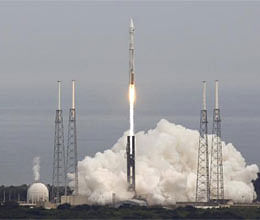
NASA’s newest robotic explorer, Mars Atmosphere and Volatile EvolutioN (Maven), rocketed toward Mars on Monday on a quest to unravel the ancient mystery of the red planet’s radical climate change.
The Maven spacecraft is due at Mars next fall following a journey of more than 700 million km.
Scientists want to know why Mars went from being warm and wet during its first billion year to cold and dry today. The early Martian atmosphere was thick enough to hold water and possibly support microbial life. But much of that atmosphere may have been lost to space, eroded by the sun.
Maven set off through a cloudy sky Monday afternoon in its effort to provide answers. An unmanned Atlas V rocket put the spacecraft on the proper course for Mars, and launch controllers applauded and shook hands over the success.
An estimated 10,000 NASA guests gathered for the launch, the most exciting one of the year from Cape Canaveral. The University of Colorado at Boulder, which is leading the Maven effort, was represented by a couple thousand people.
“We’re just excited right now and hoping for the best,” said the university’s Bruce Jakosky, Principal Scientist for Maven.
To help solve this environmental puzzle at the neighboring planet, Maven will spend an entire Earth year measuring atmospheric gases once it reaches Mars on September 22, 2014. The mission costs $671 million.
This is NASA’s 21st mission to Mars since the 1960s. But it’s the first one devoted to studying the Martian upper atmosphere.
Maven bears eight science instruments. The spacecraft, at 2,450 kgs, weighs as much as an SUV. From solar wingtip to wingtip, it stretches 37.5 feet, about the length of a school bus.
Unlike the 2011-launched Curiosity rover, Maven will conduct its experiments from orbit around Mars.
Maven will dip as low as 125 kms above the Martian surface, sampling the atmosphere. The lopsided orbit will stretch as high as 6,218 kms.
The Maven spacecraft is due at Mars next fall following a journey of more than 700 million km.
Scientists want to know why Mars went from being warm and wet during its first billion year to cold and dry today. The early Martian atmosphere was thick enough to hold water and possibly support microbial life. But much of that atmosphere may have been lost to space, eroded by the sun.
Maven set off through a cloudy sky Monday afternoon in its effort to provide answers. An unmanned Atlas V rocket put the spacecraft on the proper course for Mars, and launch controllers applauded and shook hands over the success.
An estimated 10,000 NASA guests gathered for the launch, the most exciting one of the year from Cape Canaveral. The University of Colorado at Boulder, which is leading the Maven effort, was represented by a couple thousand people.
“We’re just excited right now and hoping for the best,” said the university’s Bruce Jakosky, Principal Scientist for Maven.
To help solve this environmental puzzle at the neighboring planet, Maven will spend an entire Earth year measuring atmospheric gases once it reaches Mars on September 22, 2014. The mission costs $671 million.
This is NASA’s 21st mission to Mars since the 1960s. But it’s the first one devoted to studying the Martian upper atmosphere.
Maven bears eight science instruments. The spacecraft, at 2,450 kgs, weighs as much as an SUV. From solar wingtip to wingtip, it stretches 37.5 feet, about the length of a school bus.
Unlike the 2011-launched Curiosity rover, Maven will conduct its experiments from orbit around Mars.
Maven will dip as low as 125 kms above the Martian surface, sampling the atmosphere. The lopsided orbit will stretch as high as 6,218 kms.









